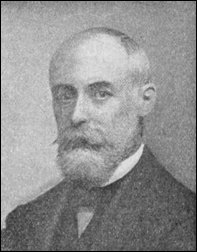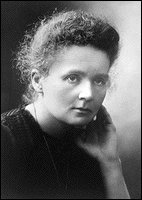Phosphorescence, X-rays and Radiation
Author: Andrew R. Barron
 |
| Antoine Henri Becquerel (1852 - 1908). |
Our story starts with the French physicist Antoine Henri Becquerel and his study at the Ecole Polytechnique in Paris of phosphorescence. Phosphorescence is an effect whereby a material will glow (or emit light) without any perceptible heat. Phosphorescent paints have long been used on the dials of wristwatches to allow the time to be read in the dark.
 |
| Maria Sklodowska Curie in 1911. |
In 1896 Becquerel was studying phosphorescence, and he believed, incorrectly, that X-ray, which had been recently discovered, were connected to phosphorescence. He wrapped a uranium compound [potassium uranyl sulfate, K4(UO2)6(SO4)3OH10.4H2O] that was known to be phosphorescent in black paper next to a photographic plate. The idea being that if phosphorescence generated X-rays then the photographic paper would show the evidence since while visible light would not travel through the black paper, any X-rays would. However, during a particularly cloudy day in Paris he decided that the light was insufficient for his experiment; he placed the uranium compound and the film in a dark draw. To his surprise the photographic paper still showed spots! His conclusion was that the uranium compound gave off radiation that he thought to be X-rays. His student Marie Curie gave the phenomenon a name: radioactivity. Curie continued her studies and found many elements gave off radiation. Based upon her studies it is known there are three forms of radiation.
| Name |
Source |
Comment |
| Alpha (α) |
Helium nucleus, He2+ |
Easily stopped by paper as well as skin and light clothing |
| Beta (β) |
High energy electrons, e- |
Stopped by a few mm of metal, dense wood or heavy clothing |
| Gamma (γ) |
Electromagnetic radiation |
Only stopped by cm of lead or thick concrete wall |
So it was known that atoms emit radiation, i.e., radiation is an atomic not molecular effect. However, a big question remained. When uranium was seen to emit α and β all the particles travel at high speed with lots of energy. So where does this energy come from?
The Law of conservation of energy states, that the total amount of energy in an isolated system remains constant. But the emission of high-energy particles during radiation seems to break the law of conservation of energy. Scientists decided it was necessary to develop an explanation of this observation without the impossible situation of breaking a fundamental law of physics.
|


 Nuclear Chemistry
Nuclear Chemistry  Phosphorescence, X-rays and Radiation
Phosphorescence, X-rays and Radiation





 Nuclear Chemistry
Nuclear Chemistry  Phosphorescence, X-rays and Radiation
Phosphorescence, X-rays and Radiation


